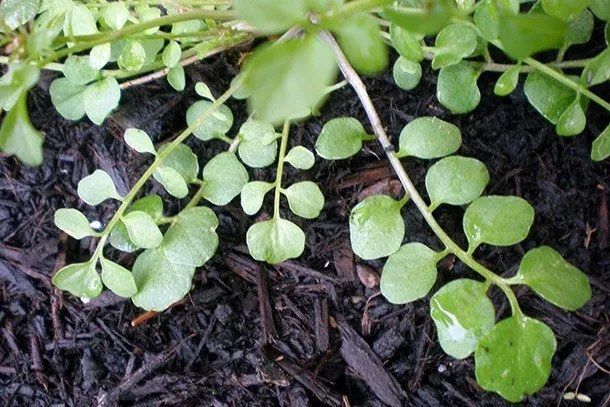Posted: February 28, 2025
Understanding a weed's life cycle—its growth and reproduction pattern—is the first step in controlling your weeds. Horticulturists have three weed life-cycle classifications: annual, biennial, and perennial.

Pinnately compound leaves with rounded leaflets. Photo: Peter Landschoot, Penn State
Some rely on Punxsutawney Phil to predict the coming of spring. For many home gardeners, the true harbinger is the appearance of weeds. The first clumps of hairy bittercress (Cardamine hirsuta) that sprout in the garden mean spring is here, bringing with it cool weather weeds and the start of the battle to control them.
Understanding a weed's life cycle—its growth and reproduction pattern—is the first step in controlling your weeds. Horticulturists have three weed life-cycle classifications: annual, biennial, and perennial.
Weed Classification
Annual Weeds
Annual weeds complete their life cycle in one year. They grow from seed, flower, produce seed, then die. Most annual weeds germinate in cool weather and emerge in early spring when the soil temperature stays above 50°F for a week or longer, usually in early April in our area. Surviving seeds lie dormant during the summer, then emerge in early fall, when the soil temperature cools.
Common annual weeds you may see in your garden soon include annual bluegrass (Poa annua), common chickweed (Stellaria media), common groundsel (Senecio vulgaris), hairy bittercress, henbit dead-nettle (Lamium amplexicaule), purple deadnettle (Lamium purpureum), shepherd's purse (Capsella bursa-pastoris), and yellow rocket (Barbarea vulgaris).
Wild violets (Viola spp.) and fleabane (Erigeron annuus) are aggressive native plants that may not be welcome in well-tended beds or lawns but are tolerated in wild spaces for their attractiveness to early pollinators.
Biennial Weeds
Biennial weeds complete their life cycle in two years. In the first year, they grow roots and leaves; in the second year, they flower, seed, and then die. Common biennial weeds that grow in early spring in our area include common burdock (Arctium minus), garlic mustard (Alliaria petiolata), henbit dead-nettle, poison hemlock (Conium maculatum), and Queen Anne's lace (Daucus carota).
Evening primrose (Oenothera biennis) is a native biennial that is an aggressive species viewed by some gardeners as a weed.
Perennial Weeds
Like other perennial plants, perennial weeds live for two or more years and reproduce from seed or spread from their roots. They can be challenging to eradicate but can be controlled. Common cool-weather perennial weeds that grow locally include broadleaf plantain (Plantago major), Canada thistle (Cirsium arvense), creeping buttercup (Ranunculus repens), dandelion (Taraxacum officinale), Japanese knotweed (Reynoutria japonica), yellow woodsorrel (Oxalis stricta), and wild garlic (Allium ursinum).
Lawn and Garden Weed Control
The common element among all three life cycles is seed production. No seeds, no (or fewer) weeds! The most common ways to prevent weeds from producing seeds are physical and chemical.
Gardeners can mix and match many physical weed control methods. Hand pulling is especially effective for removing small weeds. Cutting weeds repeatedly at the soil level with a hand or long hoe is well suited to clearing large areas. Mowing frequently keeps lawn weeds from maturing. Mulching helps smother seeds and prevent germination. A lawn torch is effective at burning and killing small weeds. All methods weaken or destroy weeds and their roots, which reduces seed production and plant reproduction.
Note that poison hemlock should not be hand-pulled without taking precautions to protect the skin and it should never be burned as it can release toxic chemicals.
Numerous pre- and post-emergent herbicides are available as chemical controls for weeds. Pre-emergent herbicides prevent weed seedlings from growing and are best applied when the soil temperature reaches 55 degrees or higher for five days in a row.
Apply most post-emergent herbicides directly on the weed while it is actively growing, usually between mid-May and mid-September, when the soil temperature is 70°F or higher. Formulations are available to treat specific weeds and for application on lawns and flower beds without harming the surrounding vegetation. When applying any herbicide, always follow the manufacturer's directions, wear appropriate personal protection, and dispose of empty containers appropriately.
Unsure which weed you have in your lawn or garden? Consult these resources for additional information. They include photos of dozens of weeds found in home lawns and gardens. If you're looking for an app to help identify a weed, check the University of Michigan Extension's article that evaluates current plant ID phone apps.

